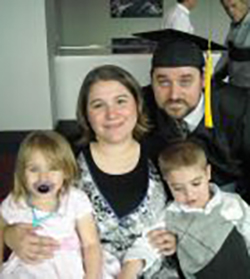THE DYSFERLINOPATHY JOURNEY
Individual Stories
THE DYSFERLINOPATHY JOURNEY
Individual Stories
Home ❯ Patients/Clinicians ❯ The Dysferlinopathy Journey ❯ Individual Stories ❯ Jennifer
Jennifer

The first hint of a problem occurred when I donated blood at age 16. I was suspected of having hepatitis due to elevated ALT levels. The same thing happened on a second blood donation, but I tested negative for hepatitis. In trying to find the cause of the high enzyme levels, I was treated with steroids, underwent a liver biopsy and a spinal tap, and consulted a hematologist, but no explanation was found. A year later, I began to have difficulty climbing stairs. I then had numerous orthopedic tests and X-rays, but still no diagnosis. When I was 19, I saw a neurologist for something unrelated. The neurologist was baffled that I couldn’t walk on my toes, but once again, did not offer a diagnosis.
At 23, I fell while holding my newborn son at the pediatrician’s office. It was scary and embarrassing — thank goodness my baby was unharmed. I fell twice more in a short period of time and knew that something was really wrong. After more blood tests, and an electromyogram, I had a muscle biopsy. The doctors discovered that I had dysferlinopathy. There was no history of dysferlinopathy in my family, but after my diagnosis my younger sister realized she had similar symptoms and CK levels confirmed that she also had this disease (later, my brother was also diagnosed). We were told that there was nothing that could be done. The lack of information was very frustrating. I remember that the neurologist’s response to my every question was “your guess is as good as mine.” We scoured the internet, but quickly discovered that there was little information, and no hope for a treatment. It was especially heart wrenching to watch my parents and husband struggle with this hopelessness. Finally, my sister found a footnote in the MDA’s Quest magazine about the Jain foundation.
We were excited that there was an organization that was specifically devoted to our condition. At the Jain Foundation, we found the information and hope that we needed. Last year, I was able to participate in a research study, because I had my genetic testing done via the Jain Foundation’s program. I also participated in the Jain Foundation’s annual conference last year and was grateful for the opportunity to share my story, meet other patients, and most importantly, to see the amazing scientists who share their ideas, brainstorm, and work together. The dedication of these people is what moves the science forward, and keeps me and my family going. Of course I hope for a treatment, but being part of the journey to find one, regardless of the outcome, is enough. It brings hope to my life, and gives my family something to hold onto as we look towards a future full of challenges we did not see coming.
The support of the Jain foundation is second only to my faith in dealing with this disability.
